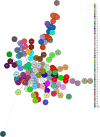Staphylococcal Cassette Chromosome mec Typing and Multilocus Variable Number Tandem Repeat Analysis of Methicillin Resistant Staphylococcus aureus Clinical Isolates with Vancomycin Creep Phenomenon
- PMID: 35915809
- PMCID: PMC9338391
- DOI: 10.2147/IDR.S368912
Staphylococcal Cassette Chromosome mec Typing and Multilocus Variable Number Tandem Repeat Analysis of Methicillin Resistant Staphylococcus aureus Clinical Isolates with Vancomycin Creep Phenomenon
Abstract
Background: The association of treatment failure and mortality with vancomycin minimum inhibitory concentration creep (MIC) is a matter of serious concern in patients with severe methicillin resistant Staphylococcus aureus (MRSA) infections. The purpose of the study was to identify and characterize staphylococcal cassette chromosome mec (SCCmec) and clonal types of MRSA strains, exhibiting the vancomycin MIC creep phenomenon.
Methods: A total of 3305 S. aureus strains were isolated from various clinical samples of Lahore General Hospital, Lahore, Pakistan. MRSA strains were identified by cefoxitin resistant (≤21mm) followed by mecA and mecC gene genotyping. Vancomycin MIC creep was determined by E-test. Isolates having MIC values >1.5 µg/mL were further subjected for SCCmec typing (I-V and XI) and multiple-locus variable number tandem repeat analysis (MLVA) by amplification of spa, sspA, clfA, clfB, and sdrCDE genes. A dendrogram was created based on the similarity index using bioneumerics software.
Results: About 13.3% (440/3305) isolates were MRSA with 99.3% (437/440) and 0.7% (3/440) carried mecA and mecC genes, respectively. In 120 MRSA isolates, the MIC of vancomycin was >1.5µg/mL. In MRSA isolates with high vancomycin MIC (>1.5µg/mL), the most common SCCmec type was SCCmec III (38.3%), followed by SCCmec IVa (15.8%), SCCmec IIIa (13.3%,), SCCmec IVc (7.5%), SCCmec IVe (5.8%), SCCmec IVd (5.8%), SCCmec IVb (4.2%), SCCmec II (2.5%), SCCmec V (1.7%), SCCmec I (1.7%) and SCCmec XI (1.7%). MLVA revealed 60 genotypic groups of MRSA isolates having a 92% similarity index.
Conclusion: SCCmec III was the most common type in genetically related MRSA isolates showing vancomycin MIC creep. The presence of SCCmec XI may further add burden to infection control measures.
Keywords: methicillin resistant Staphylococcus aureus; multilocus variable number tandem repeat analysis; staphylococcal chromosomal cassette.
© 2022 Arshad et al.
Conflict of interest statement
The authors have no relevant financial or nonfinancial interest to disclose in this work.
Figures





Similar articles
-
High prevalence of direct repeat unit types of 10di, 8 h and 8i among methicillin resistant Staphylococcus aureus strains with staphylococcal cassette chromosome mec type IIIA isolated in Tehran, Iran.Antimicrob Resist Infect Control. 2019 Mar 6;8:50. doi: 10.1186/s13756-019-0501-y. eCollection 2019. Antimicrob Resist Infect Control. 2019. PMID: 30886703 Free PMC article.
-
An investigation of vancomycin minimum inhibitory concentration creep among methicillin-resistant Staphylococcus aureus strains isolated from pediatric patients and healthy children in Northern Taiwan.J Microbiol Immunol Infect. 2017 Jun;50(3):362-369. doi: 10.1016/j.jmii.2015.05.013. Epub 2015 Jun 27. J Microbiol Immunol Infect. 2017. PMID: 26297168
-
Prevalence of methicillin-resistant Staphylococcus aureus (MRSA) infection and the molecular characteristics of MRSA bacteraemia over a two-year period in a tertiary teaching hospital in Malaysia.BMC Infect Dis. 2017 Apr 13;17(1):274. doi: 10.1186/s12879-017-2384-y. BMC Infect Dis. 2017. PMID: 28407796 Free PMC article.
-
Staphylococcus aureus Infections in Malaysia: A Review of Antimicrobial Resistance and Characteristics of the Clinical Isolates, 1990-2017.Antibiotics (Basel). 2019 Aug 26;8(3):128. doi: 10.3390/antibiotics8030128. Antibiotics (Basel). 2019. PMID: 31454985 Free PMC article. Review.
-
Methicillin-resistant Staphylococcus aureus (MRSA) and anti-MRSA activities of extracts of some medicinal plants: A brief review.AIMS Microbiol. 2019 Apr 15;5(2):117-137. doi: 10.3934/microbiol.2019.2.117. eCollection 2019. AIMS Microbiol. 2019. PMID: 31384707 Free PMC article. Review.
References
-
- Kaleem F, Usman J, Khalid A, Hassan A, Omair M. Comparison of in vitro efficacy of linezolid and vancomycin by determining their minimum inhibitory concentrations against methicillin resistant Staphylococcus aureus (MRSA). J Pak Med Assoc. 2011;61(4):356–359. - PubMed
LinkOut - more resources
Full Text Sources
Molecular Biology Databases

